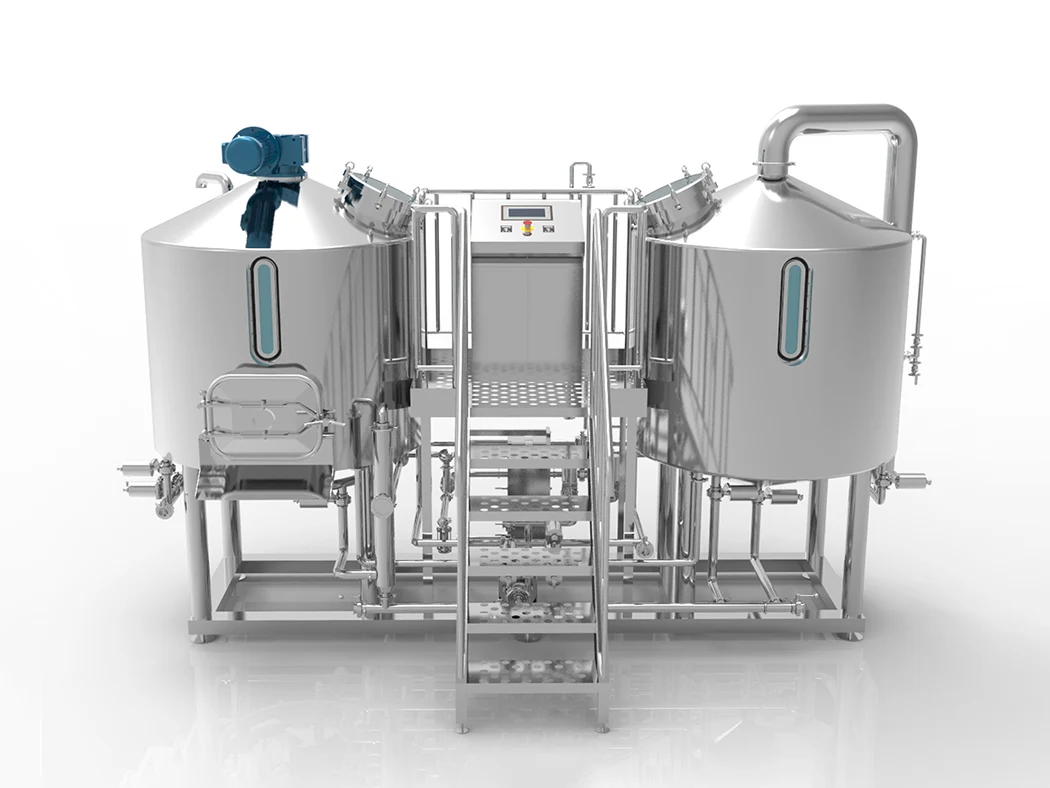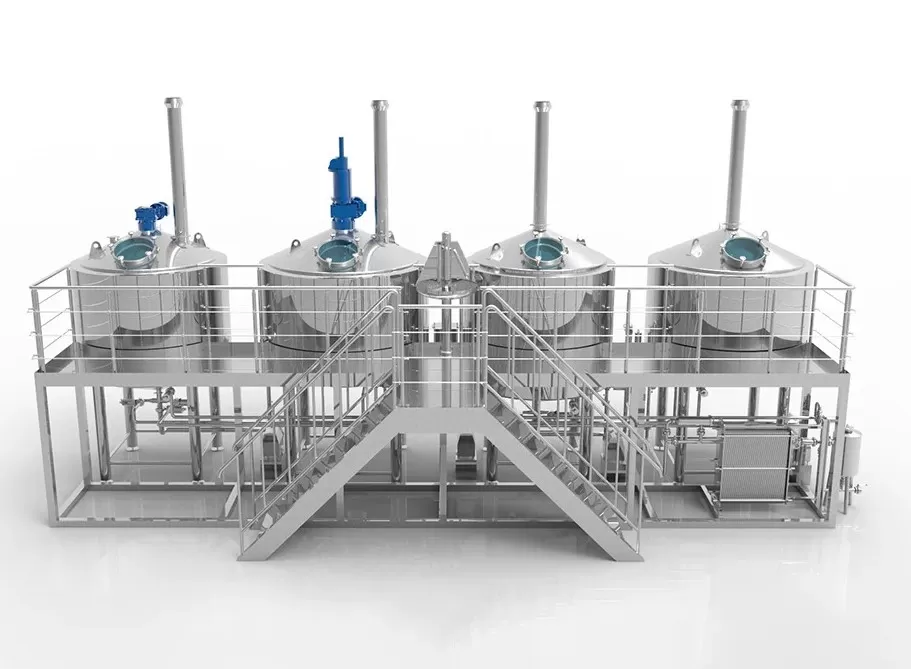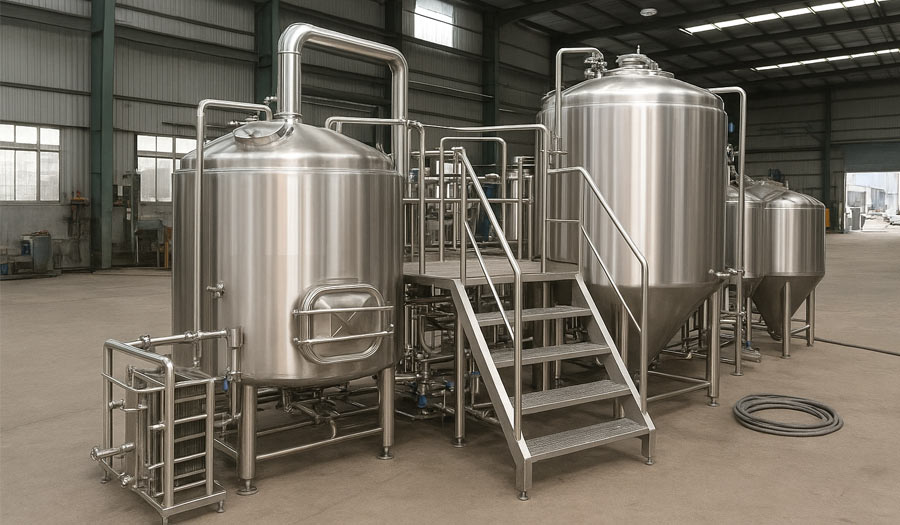By 2025, the global brewing equipment industry is expected to show steady growth. According to statistics, the total market size reached approximately USD 20.52 billion in 2024 and is projected to grow to USD 21.69 billion in 2025, with a compound annual growth rate of about 5.7%, according to The Business Research Company. This growth is largely driven by the popularity of craft beer in emerging and developed markets, increasing consumer demand for flavor and quality, and investments in automation and sustainability technologies.
However, the price of 양조 장비 is not uniform; it varies significantly depending on factors such as scale, level of automation, material standards, brand, and costs for transportation and installation.
2025 Brewing Equipment Price Overview
By 2025, brewing equipment prices continue to show clear tiered differences:
- Nano / 1–3 BBL Systems: Total investment ranges from USD 10,000 to 50,000, suitable for brewpubs, laboratories, and entry-level startups.
- Small Craft Breweries (5–15 BBL): Equipment investment is approximately USD 100,000 to 500,000.
- Commercial Large-Scale Plants (30 BBL and above): Often require USD 500,000 to 1,000,000+, especially when including automation, cooling systems, and packaging lines.
Scale Type | Typical Capacity (BBL) | Investment Range (USD) | Main Application Scenarios |
Nano System | 1–3 BBL | 10,000 - 50,000 | Brewpubs, restaurants, labs, entry-level startups |
소규모 수제 맥주 양조장 | 5–15 BBL | 100,000 – 500,000 | Independent craft breweries, small-batch specialty brewing |
Commercial Large Plant | 30+ BBL | 500,000 – 1,000,000+ | Large-scale beer production, often including automation, cooling, and packaging lines |
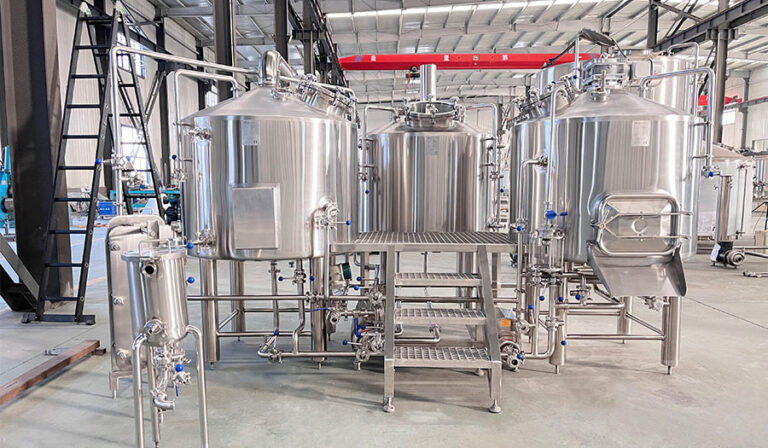
Analysis of Brewing Equipment Stages, Functions, and Price Overview
Raw Material Processing Equipment
The raw material processing stage mainly includes sieves, destoners, and grinders. Its function is to remove impurities and adjust the particle size of the raw materials, making starch more accessible for mash and enzymatic hydrolysis. Equipment prices vary widely: small grinders cost approximately USD 2,000–10,000, while larger or highly automated systems can exceed USD 20,000.
Malting and Mashing Equipment
The malting stage typically uses malting tanks or malting machines to ensure barley germination and enzyme formation. Mashing relies on mash tuns, stirring devices, and heating/control systems to convert starch into fermentable sugars, producing wort. A single mash tun generally costs USD 10,000–50,000, while a complete mashing system usually requires an investment of USD 50,000–200,000.
Wort Filtration and Boiling Equipment
After mashing, wort must be separated from solid residues using filtration tanks or membrane filters. Boiling kettles and whirlpool tanks are then used for sterilization, addition of hops, and wort concentration. Filtration equipment typically costs USD 10,000–80,000, while boiling kettles range from USD 15,000–100,000.
Cooling and Fermentation Equipment
The boiled wort is rapidly cooled using a plate heat exchanger and aerated before entering the fermentation tanks. Fermentation tanks (commonly conical) provide precise temperature and pressure control to ensure stable yeast activity. Plate heat exchangers cost approximately USD 5,000–30,000, and individual fermentation tanks range from USD 5,000 to 50,000, depending on capacity.
Conditioning and Clarification Equipment
After fermentation, beer is transferred to conditioning tanks for cold maturation, allowing flavors to harmonize. Clarification of the beer often involves diatomaceous earth filters, membrane filters, or centrifuges. Conditioning tanks typically cost USD 5,000–40,000 each, while clarification equipment ranges from USD 10,000–100,000.
Packaging and Filling Equipment
Packaging includes bottle washers, fillers, cappers, and labelers to ensure sterile, sealed beer while maintaining CO₂ content and flavor. Semi-automatic equipment costs around USD 10,000–50,000, whereas fully automatic production lines may require USD 100,000–500,000 or more.
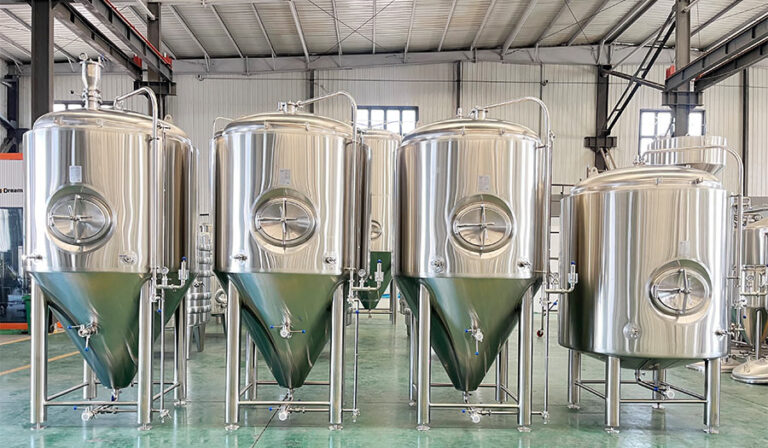
Auxiliary and Control Systems
Auxiliary systems include boilers, refrigeration units, air compressors, water treatment equipment, and automated control systems. They provide heat, cooling, purified water, and stable process control. The total investment for these systems is typically USD 50,000–200,000+.
Overall Investment Reference
Overall, brewing equipment investment in 2025 varies significantly by scale:
- Nano systems (1–3 BBL): approximately USD 10,000–50,000, suitable for brewpubs or labs.
- Small craft breweries (5–15 BBL): around USD 100,000–500,000.
- Large commercial plants (30 BBL and above): often require USD 500,000–1,000,000+, especially when including automation, cooling, and packaging lines.
Key Factors Affecting Brewing Equipment Prices
- Automation and Control Level: Manually operated equipment is generally less expensive, while semi-automatic or fully automated systems with integrated sensors, PLC/SCADA systems, and big data monitoring significantly increase costs.
- Stainless Steel Material and Structural Standards: Most equipment uses food-grade stainless steel (e.g., 304 or 316L), but factors such as thickness, polishing, jacketed structures, and pressure ratings affect the price.
- Scale and Capacity: Larger unit capacities generally reduce marginal costs, but ultra-large capacities or multiple parallel systems can increase size and component costs.
- Brand, Quality, and Service: Well-known brands usually charge higher prices but provide better warranties, service networks, and spare parts. Smaller manufacturers may offer better value but carry higher risk.
- Transportation, Installation, and Commissioning: Costs for shipping, on-site installation, piping, electrical connections, and commissioning can be significant, often accounting for 10%–20% or more of total cost.
- Customization and Localization Requirements: Custom designs to meet local voltage, regulations, space layout, or sanitary standards can add additional costs.
- Exchange Rates, Tariffs, and Import/Export Fees: Cross-border equipment procurement is heavily influenced by currency fluctuations, tariffs, import taxes, and shipping costs.
Beer Brewing Equipment Investment and Operating Costs
Investment Costs (Fixed Costs)
Equipment Purchase Costs
- Main Production Equipment: Mash system (mash tuns, lauter tun, boiling kettle, whirlpool), fermentation tanks, cooling systems, filtration equipment, filling lines.
- Auxiliary Equipment: Boilers, refrigeration units, air compressors, water treatment systems, CIP cleaning systems.
- Cost Proportion: Fermentation and conditioning tanks usually account for the highest share, about 40%–50% of total equipment investment.
Plant and Infrastructure
- Includes plant construction, foundation reinforcement, piping layout, cold storage facilities, etc.
- Accounts for approximately 15%–25% of total investment; larger-scale plants benefit from lower cost per unit.
설치 및 커미셔닝
- Costs for equipment transport, installation, commissioning, process piping, and electrical connections.
- Typically 10%–15% of the equipment purchase cost.
Other Initial Costs
- Design fees, license applications, inspection and certification, training costs.
- Relatively small, but essential for project startup.
Operating Costs (Variable and Fixed Expenses)
Raw Material Costs
- Malted barley, corn, rice, and other starch raw materials.
- Hops, yeast, and additives.
- Accounts for the largest portion of operating costs, about 50%–60% of total costs.
Energy Consumption
- Steam: Used in mashing and boiling.
- Electricity: Powers stirring, refrigeration, and compressed air systems.
- Water: Used in mashing, cleaning, and cooling; beer production typically consumes 3–7 times the product volume in water.
Labor Costs
- Brewing technicians, equipment operators, quality control personnel, logistics, and management staff.
- Varies with automation level; highly automated plants can significantly reduce labor cost proportion.
Equipment Maintenance and Depreciation
- Depreciation: Typically calculated over 10–15 years.
- Maintenance: Routine upkeep, replacement of wear parts, CIP cleaning consumables.
Packaging and Logistics Costs
- Includes glass bottles, aluminum cans, kegs, and their recycling/maintenance.
- Packaging costs account for about 15%–25% of operating costs.
- Transportation and cold chain logistics depend on the sales distribution range.
Management and Marketing Expenses
- Brand promotion, channel development, taxes, and other administrative expenses.
- Proportion tends to decrease as production scales up.
2025 Brewing Equipment Development Trends
Deepening Technology and Automation
- IIoT and Smart Sensor Integration: Equipment increasingly uses online sensors (e.g., DO, CO₂, turbidity, temperature, pressure) to monitor key stages like fermentation and cooling in real time, allowing earlier detection of abnormalities and improving stability and consistency.
- Automated Cleaning Systems (CIP/SIP Validation): Cleaning and sanitization consume significant water and energy and are critical for hygiene management. By 2025, more equipment will feature automatic verification (e.g., temperature, flow, conductivity) and efficient, water-saving modes.
- Digital Control and Remote Management: Cloud or edge computing enables remote monitoring and adjustment of brewing parameters (fermentation temperature, mashing conditions) and the use of digital twins to simulate and predict fermentation processes, reducing manual sampling and inspection frequency.
- Flexible / Modular Systems: To meet growing demand for craft, small-batch, multi-style brewing, equipment is moving toward modular, expandable, and quick-change systems. Batch switching and recipe adjustments take less time.
- AI and Machine Learning Applications: AI is applied in recipe optimization, quality monitoring, fault diagnosis, and yield prediction. Machine learning can analyze historical data, predict fermentation completion, reduce losses, and improve efficiency.
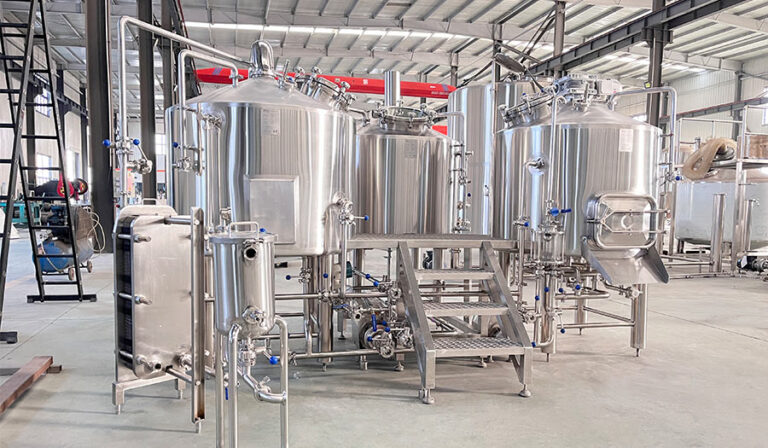
Strengthening Sustainability and Environmental Protection
- Energy-Saving Measures and Heat Recovery: Examples include recovering heat from boiling kettles, heat exchange systems, and insulated buildings/tanks to reduce steam and electricity consumption. Heat pumps or solar-assisted systems are being used in some regions as alternatives to traditional boilers.
- Water Management and Recycling: Reuse of cleaning and cooling water, low-water CIP systems, and separation of potable and process water help reduce wastewater discharge.
- Sustainable Raw Materials and Supply Chain: Sourcing locally, organically, or from regenerative agriculture reduces transport emissions and pesticide use. Beer by-products (spent grains, brewers’ grains) can be reused as animal feed, food ingredients, or for energy recovery.
- Eco-Friendly Packaging and Materials: Lighter glass bottles, recyclable/reusable cans and bottles, environmentally friendly inks (e.g., water-based), and biodegradable or recyclable packaging materials are prioritized. Automated packaging lines also help reduce waste.
Market- and Product-Driven Equipment Evolution
- Strong Small-Batch / Craft Demand: Consumers prefer diverse flavors, limited editions, and unique taste profiles. This drives manufacturers to offer small-scale, highly flexible, quick-change brewing systems.
- Low/Non-Alcohol Beer Equipment Optimization: Rising health awareness boosts demand for low- or non-alcohol beer, requiring special control and optimization in fermentation, dealcoholization, and flavor restoration. Although the technology is still developing, equipment improvements are already a trend.
- Higher Quality and Consistency Standards: Consumer demand for stable flavor and quality forces equipment in temperature control, oxygen control, mixing, and filtration to become more precise, with lower tolerance for error.
- Regulations and Certification Driving Compliance: Environmental laws (emissions, water treatment, food safety) and clean production requirements push equipment to meet higher standards (e.g., hygienic design, cleanability, monitoring, and recording functions). Equipment is increasingly required to comply with local and export standards.
요약
In conclusion, brewing equipment prices in 2025 vary significantly depending on scale and automation level. Costs can start at tens of thousands of dollars for small nano systems, reach hundreds of thousands for medium-sized craft breweries, and exceed one million dollars for large industrial-scale plants. The key factors are the desired production capacity, level of automation, equipment standards, brand, and after-sales maintenance.You can contact Micet Group to explore customized brewing equipment solutions and help make your brewing dreams a reality!

